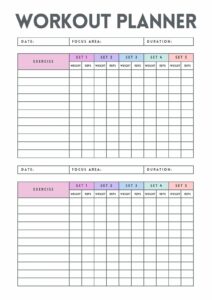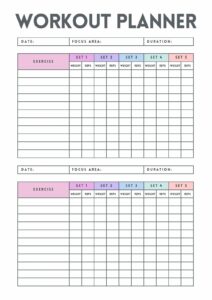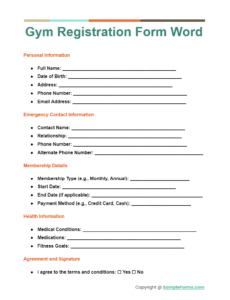Embarking on a weight training journey, or even if you’re a seasoned lifter, often feels like a constant pursuit of progress. You step into the gym, lift some heavy things, and hope for the best. But hoping isn’t a strategy, is it? To truly unlock your potential, to see consistent gains in strength, muscle, and overall fitness, you need more than just effort; you need a roadmap, a way to track where you’ve been and where you’re going.
That’s where the magic of organized tracking comes in. Imagine being able to look back at your last session, remember exactly what weight you lifted, how many reps you managed, and how you felt. This isn’t just about satisfying curiosity; it’s about making informed decisions for your next workout, pushing past plateaus, and celebrating every small victory. A well-designed weight training workout log template isn’t just a piece of paper or a digital file; it’s your personal coach, strategist, and motivational tool all rolled into one.
Why a Weight Training Workout Log Template is Your Secret Weapon
Think of your weight training workout log template as the ultimate tool for strategic progress. Without it, you’re essentially flying blind in the gym. You might recall your last bench press set, but what about your overhead press from three weeks ago? Did you increase the weight, or did you accidentally go lighter? This kind of guesswork can hinder your progress and even lead to injury if you’re not progressively overloading your muscles in a smart, systematic way.
A log eliminates the guesswork. It provides concrete data that shows you exactly what you did, allowing you to replicate successful workouts or identify areas that need adjustment. This data-driven approach is fundamental to the principle of progressive overload, which is the cornerstone of building strength and muscle. You can’t consistently add weight, reps, or sets if you don’t remember what you did last time.
Beyond just tracking sets and reps, a comprehensive log allows you to note how you felt on a particular day, your energy levels, any minor aches, or even external factors like sleep quality. These qualitative notes are incredibly valuable for understanding your body’s response to training and making smarter decisions about your recovery and future sessions. It turns your workout into an experiment where you’re constantly learning about your own physical limits and capabilities.
Key Elements Your Log Should Capture
- Date and Time: Essential for understanding consistency and recovery periods.
- Exercise Name: Be specific (e.g., Barbell Back Squat, Dumbbell Incline Press).
- Sets and Reps: The core of your workout data.
- Weight Used: Crucial for tracking progressive overload.
- Rest Periods: Important for managing intensity and recovery within a session.
- RPE (Rate of Perceived Exertion) or RIR (Reps In Reserve): Helps gauge effort level and fatigue.
- Notes: A space for anything else relevant – how you felt, technique observations, personal bests, mood, etc.
Ultimately, a weight training workout log template transforms your training from a series of disconnected sessions into a cohesive, goal-oriented program. It empowers you to take control of your fitness journey, offering clarity, accountability, and undeniable proof of your hard work. This visual representation of your progress is a powerful motivator, pushing you to constantly strive for improvement and reminding you how far you’ve come.
How to Make the Most of Your Workout Tracking
Simply having a weight training workout log template isn’t enough; you need to engage with it consistently and intelligently. The real power of a log comes from its diligent use and subsequent analysis. Make it a non-negotiable part of your workout routine, whether that means jotting things down immediately after each set or sitting down for a few minutes post-workout to fill in the details. Consistency here is paramount, as gaps in your data can be just as unhelpful as having no log at all.
Once you’ve built up a collection of data, set aside time periodically to review your progress. This could be weekly, monthly, or at the end of a specific training block. Look for trends: Are you consistently adding weight to certain lifts? Are there exercises where you’re stalled? Are your RPEs consistently high, indicating you might need a deload? This review process is where the “coach” aspect of your log truly shines, allowing you to identify strengths, weaknesses, and areas for improvement.
Using the insights gained from your log, you can then strategically adjust your future workouts. If you notice you’ve been stuck on a particular lift for weeks, maybe it’s time to try a different rep scheme, add a variation, or focus on technique. If you’ve been progressing rapidly, perhaps you can push a bit harder. This iterative process of tracking, analyzing, and adjusting is what drives long-term gains and prevents plateaus.
Here are a few tips to elevate your logging game:
- Be Consistent: Make logging a part of your post-workout routine.
- Review Regularly: Check your progress weekly or monthly.
- Adjust Strategically: Use insights to plan your next training block.
- Don’t Forget Notes: Capture how you felt, energy levels, and any pain.
Whether you opt for a digital app on your phone, a simple notebook and pen, or a printable spreadsheet, find a format that works best for your personal preferences and lifestyle. The best log is the one you will actually use regularly, not the most complex one. Experiment with different options until you discover the method that feels most natural and integrated into your training.
Embracing the habit of meticulously logging your weight training workouts is perhaps one of the most impactful decisions you can make for your fitness journey. It’s a simple yet incredibly powerful practice that moves you from aimless effort to purposeful, strategic training. By documenting your efforts, celebrating your incremental wins, and learning from every session, you’re not just lifting weights; you’re building a stronger, more knowledgeable, and ultimately more successful version of yourself.
So, take the leap and integrate a dedicated tracking system into your routine. The insight, motivation, and tangible progress you’ll experience are invaluable. Start recording your journey today, and watch as your commitment transforms into undeniable strength and fitness achievements that you can truly be proud of.


